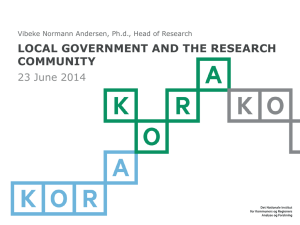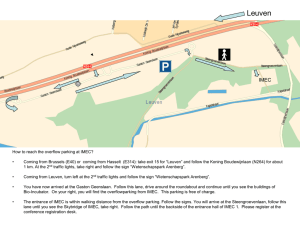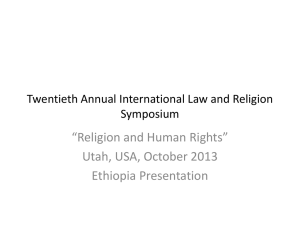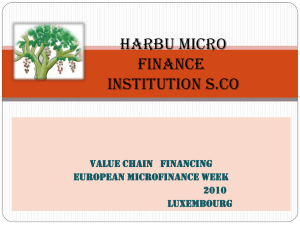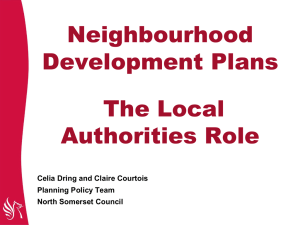North-south collaboration
advertisement
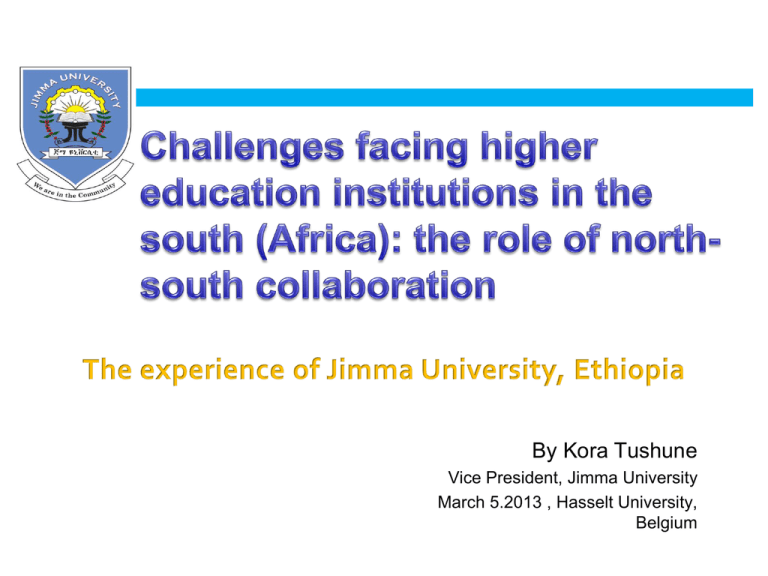
ጅማ ዩኒቨርሲቲ www.ju.edu.et By Kora Tushune Vice President, Jimma University March 5.2013 , Hasselt University, Belgium Flow of the presentation □ State of HEIs in the south □ A perspective on north-south collaboration (NSC) □ Overview of Jimma University IUC Program as an example of NSC □ Concluding remark and way forward □ Caveats: South is discussed with emphasis on Africa Presentation is highly influenced by actual experience Kora Tushune. North-South Presentation, Hasselt University, March 5, 2013 Higher education (HE) in Africa □ Higher education is crucial for economic growth of countries. There are many evidences that associate economic growth with education in general and HE in particular. □ Higher education system is a hub of knowledge generation, reproduction, and dissemination in a given society (technological catch-up). □ World bank and other development partners downplayed this fact and neglected higher education in 1980s and 1990s Kora Tushune. North-South Presentation, Hasselt University, March 5, 2013 Higher education (HE) in Africa (2) □ As in many areas of development, Africa has lagged behind in higher education; it has the lowest enrolment. □ Without a strong higher education system (universities, colleges, TVETs, etc) Africa will miss out on the emerging global knowledge based economy and cannot build a competitive economy. Kora Tushune. North-South Presentation, Hasselt University, March 5, 2013 Benefits of higher education □ Economic benefits (productivity, GDP, R&D,…) □ Social and political benefits □ Human capital and professional development □ Knowledge generation and adaptation through research and innovation □ Equitable opportunity and access provision □ Support other levels of education □ Promote linkage to world of work □ Promote international cooperation Kora Tushune. North-South Presentation, Hasselt University, March 5, 2013 State of science and research in Africa (1) □ Universities are centers of teaching, research and community engagement; they boost productivity, competitiveness and economic growth. □ In Africa the state of science and research is worrisome . The region has one of the lowest research expenditure, research staff and scientific outputs. □ Few key countries produce majority of research publications of the continent (South Africa, Nigeria, Kenya, Egypt, Algeria, Uganda and Tunisia) Kora Tushune. North-South Presentation, Hasselt University, March 5, 2013 State of science and research in Africa (2) □ African research collaboration and network is also dominated by those few countries that also dominate the publication □ HEIs of many countries are not part of this established network of research collaboration □ Few HEIs of the west (from US and Europe) have dominated the network of research collaboration. □ Few researches from very few countries awarded patent from USPTO Kora Tushune. North-South Presentation, Hasselt University, March 5, 2013 State of science and research in Africa (3) □ Compared with other countries the continent has long way to go in scientific outputs. □ Many countries conduct research in biological science but few researches are conducted in science which has implication for Sustainable development research □ The mono-disciplinary nature of most of the researches had compromised their utility for SD problems. Kora Tushune. North-South Presentation, Hasselt University, March 5, 2013 State of science and research in Ethiopia □ Ethiopia is one of African countries that produce low scientific output in terms of publication. □ It poorly show up in the list of countries receiving patent from USPTO (compare this with Korea) □ It is not integrated into major research collaboration network in Africa □ Although its overall scientific output is low, its productivity is average when output per GDP is considered. Kora Tushune. North-South Presentation, Hasselt University, March 5, 2013 Challenges and constraints facing science and research (1) • • • • • • Shortage of qualified human power underfunding, and principles guiding north-south partnerships Lack of research infrastructure and excessive teaching load Uncompetitive salary and benefit packages Unattractive work environment and increasing brain drain the high cost of bandwidth and the lack of capacity to ensure the effective use of online technologies for teaching and research; Kora Tushune. North-South Presentation, Hasselt University, March 5, 2013 Challenges and constraints facing science and research (2) • Lack of research experience and poor mentoring of young researchers • Limited south-south collaboration; poor collaboration with non-academic actors (e.g. Civil society groups) Gender inequity in science and research Limited capacity for management of research projects • • Kora Tushune. North-South Presentation, Hasselt University, March 5, 2013 North-south collaboration North-south collaboration (NSC) □ NSC: has geographic and developmental connotations Refers to various forms of interaction between north and south; involves two or more countries North-south North-south-south South-south collaboration is also a growing trend. Definitions (Rosseel et el) □ North-south collaboration: is “a geographical division whereby the North represents the richer countries of North America, Europe, Japan, Australia and New Zealand, and the South represents the poorer majority of countries in Africa, Asia and Latin America” Kora Tushune. North-South Presentation, Hasselt University, March 5, 2013 Typology of N-S research collaboration □ NSC is a generic term that can take many forms Typology of Southern Partnership in research cooperation (Waardenburg, 1997) Kora Tushune. North-South Presentation, Hasselt University, March 5, 2013 Definitions □ North-south-south collaboration: is “ new route of development cooperation where aid is channeled through institutions in third-world countries in order to support development projects in poor countries. □ South-south collaboration: is “a broad concept that covers a wide range of collaborations among developing countries……more specifically to cooperative activities between newly industrialized Southern countries and other, less developed nations of the South” SSC can be exchange of experience and good practices, networking, capacity building and forging partnership Kora Tushune. North-South Presentation, Hasselt University, March 5, 2013 Evolution of north south collaboration □ There is a longstanding tradition of academic (teaching and research) collaboration between north and south institutions □ Academic collaboration evolved from predominantly ‘capacity building to equal partnerships, from social commitment to matching interests, and from specific needs to global strategies’ (Ad Boeren, 2013) □ Many countries in south faced shortage humanpower after independence; the tnorth provided training and research capacity building Kora Tushune. North-South Presentation, Hasselt University, March 5, 2013 Evolution of north-south collaboration □ Collaborations were funded from development cooperation funds □ However, the relationship between north and south tended to be unequal due to difference in capacity and experience □ The north assumed the role of preceptors; little expectation that they also learn something from the collaboration. Kora Tushune. North-South Presentation, Hasselt University, March 5, 2013 Evolution of north south collaboration □ Changing trends in the north: Expanding access to higher education with stagnation in funding Change in funding formula in the North (from inputbased to output-based financing). Internationalization and ranking Selective in areas of their expertise and avoiding low-prestige universities in the south Kora Tushune. North-South Presentation, Hasselt University, March 5, 2013 Evolution of north-south collaboration Tendency to ‘marry upwards’ in search for quick and certain returns: Universities in BRIC countries Well-established South African universities Restriction of use of development cooperation funds for academic collaboration Lack of coherent policy that coordinate efforts of relevant ministries in the north. Kora Tushune. North-South Presentation, Hasselt University, March 5, 2013 Evolution of north-south collaboration □ consequences: Decline of social commitment as a driving force for collaboration Focus on short term academic and financial benefits Financial constraints led Northern institutions to ‘marry upwards’ to prestigious institutions and the upcoming BRICs universities. Results from collaboration with low-prestige universities in the south are usually uncertain or and long-term. □ Development cooperation funds are not available for academic collaboration Kora Tushune. North-South Presentation, Hasselt University, March 5, 2013 Potential benefits of NSC □ Well-thought NSC has a mutual benefits: □ For North: Internationalization (staff and student exchange) Joint research and publication Exposure to issues and challenges of developing world Play their role as global citizens (social responsibility) Networking Kora Tushune. North-South Presentation, Hasselt University, March 5, 2013 Potential benefits of NSC □ South Transfer of knowledge, skill and technology Improvement in infrastructure and facilities Provides additional funding Human capacity building Enhanced quality of educational programs and research Academic networking Engagement with community and enhanced role in socio-economic development of their country Brain circulation Kora Tushune. North-South Presentation, Hasselt University, March 5, 2013 NSC: challenges □ North: Problem of coordination Among countries and institutions Between academic collaboration and development cooperation Concentration around few well established HEIs in the south Going for low hanging fruits and immediate results There is no strong policy that encourage faculty involvement in NSC (‘Publish or perish’ academic environment) Kora Tushune. North-South Presentation, Hasselt University, March 5, 2013 NSC: challenges □ South: Capacity problem to establish ‘partnership’ Inadequate coordination among collaborative projects Lack of facilities and infrastructure Sustainability issues Brain drain (retention of qualified staff) Project management capacity Not all needs of the south can be met Kora Tushune. North-South Presentation, Hasselt University, March 5, 2013 NSC: opportunities Global shift of attitude towards higher education especially from the WB Burgeoning economic growth in some of the developing countries BRICS countries are joining the arena Technological advancement particularly in the areas of ICT EU-Africa partnership program NSC and SS collaboration are high on the global agenda. Kora Tushune. North-South Presentation, Hasselt University, March 5, 2013 Evolution of north-south collaboration □ Way forward: Broadening the perspective of the north universities (from short term, profit oriented and egocentric perspective to a long-term and global) Investing in the future (developing countries are economic powers of tomorrow) Treating south institutions as equal partners Engaging in mutually rewarding partnership Coordination of policies in the areas of development cooperation, economic assistance , and foreign affairs Flexibility in use of development cooperation funds for policy funding collaboration Kora Tushune. North-South Presentation, Hasselt University, March 5, 2013 Ethiopia: background Kora Tushune. North-South Presentation, Hasselt University, March 5, 2013 Ethiopia in the world Kora Tushune. North-South Presentation, Hasselt University, March 5, 2013 Ethiopia in Africa Kora Tushune. North-South Presentation, Hasselt University, March 5, 2013 Ethiopian regional states and city administrations Kora Tushune. North-South Presentation, Hasselt University, March 5, 2013 Jimma University: Location Jimma Kora Tushune. North-South Presentation, Hasselt University, March 5, 2013 Ethiopia: History and Geography □ Ethiopia is a Sub-Saharan African country located in the Greater Horn region of east Africa. □ It has an area of 1.1million km2 and shares border with five countries: Kenya to the south, Somalia and Djibouti to the east, Eritrea to the north and The Sudan to the west. □ Has 3000 years of recorded history and was once a center of civilization and world power; also believed to be the origin of mankind--Lucy and Ramidus (3.5 and 5.5 million years old) □ Decisively defended its independence and was never colonized by western powers □ The country also has history of prolonged civil war and strife that consumed its resources resulting in widespread poverty; lately there is recurrent drought and famine Ethiopia: Government and Political System □ Ethiopia is a federal republic that has nine states and two city administrations. It is further divided into 819 woredas (districts) and more than 15000 kebeles (subdistricts), 10000 rural and 5000 urban □ The government is parliamentary democracy headed by the prime minister. □ The country has bicameral parliament with two houses: House of Representatives and House of Federation □ The ruling party (EPRDF) is the dominant party that ruled the country for over a decade after overthrowing leftist government headed by Mengistu Hailemariam in 1991 through armed struggle. Ethiopia: facts and figures □ Population: 84.73 million (the□ GNI per capita: $370 (low income country second most populous country in Africa) □ GDP per capita (PPP): $1,100 (2011) □ Poverty headcount ratio: 29.6% □ <5 mortality: 106 (WHO: □ Human development index: 2012)) 174/187 □ IMR: 68 (WHO: 2012)) □ Life expectancy: 59 □ Maternal mortality: 350 □ Access to the improved □ HIV/AIDS prevalence: 1.2% water sources: 34% □ Economic growth: Background □ Ethiopian higher education system Remained very small for decades up to late 1990s Repaid expansion after 1997 jumping from just two universities to 32 university within 14 years There is a huge increase in enrolment stretching the limited faculty and infrastructure; yet the participation rate is around 2% Currently the system has prioritized issues of access, equity, quality, and efficiency Kora Tushune. North-South Presentation, Hasselt University, March 5, 2013 Higher education in Ethiopia (1) □ Higher education is growing at an unprecedented rate The number of universities and colleges has increased dramatically in space of the last 15 years Gross enrolment has also jumped from thousands to hundred thousands relatively short time span. The private sector contribution to the higher education expansion is not negligible. □ With the rapid expansion quality has become an issue; measures are being taken Kora Tushune. North-South Presentation, Hasselt University, March 5, 2013 Higher education in Ethiopia (2) □ Engineering and science have been prioritized in overall intake (the 70/30 proportion), university and industry link has moved to the center of the strategy. □ The system is also aimed at achieving strategic goals of HE including equitable distribution of institutions, gender equality, operational efficiency, institutional autonomy, educational quality and relevance, capacity building, and other related issues □ Growth of graduate programs is far behind undergraduate programs; they are still in short supply. Kora Tushune. North-South Presentation, Hasselt University, March 5, 2013 Ethiopia: Higher education expansion □ Number of public Universities Source: MOE Kora Tushune. North-South Presentation, Hasselt University, March 5, 2013 Ethiopia: Higher education enrolment Education Statistics Annual Abstract 2003 E.C (2010/11) Kora Tushune. North-South Presentation, Hasselt University, March 5, 2013 Ethiopia: Higher education enrolment (2) Education Statistics Annual Abstract 2003 E.C (2010/11) Kora Tushune. North-South Presentation, Hasselt University, March 5, 2013 Ethiopia: Higher education expansion Growth of Enrolment in Higher Education □ Enrolment growth 350000 Enrolment 300000 250000 Male 200000 Female 150000 Total 100000 50000 0 2004/05 2005/06 2006/07 2007/08 2008/09 Male 108287 136581 156879 206336 228279 Female 33476 43705 53577 64020 90938 Total 141763 180286 210456 270356 319217 Kora Tushune. North-South Presentation, Hasselt University, March 5, 2013 Source: MOE JIMMA UNIVERSITY We are in the community Kora Tushune. North-South Presentation, Hasselt University, March 5, 2013 Jimma University: Location Jimma Kora Tushune. North-South Presentation, Hasselt University, March 5, 2013 Background □Located in south western part of the country, in Jimma town, 352 kms outside Addis Ababa □Established during the first wave HE expansion, in 1997; the constituent institutions are much older, 27 and 55 years □Has four campuses (Main campus, Business and Economics, Agriculture and Veterinary Medicine, and Kito Furdisa), all in Jimma town; University Teaching Hospital is part of the main campus; Agaro Campus (soon coming) Kora Tushune. North-South Presentation, Hasselt University, March 5, 2013 Background: Campuses Main Campus Main campus JUCAVM College of Agric. & Vet Medicine Institute of Technology College of Business & Economics Kora Tushune. North-South Presentation, Hasselt University, March 5, 2013 Construction of new hospital Kora Tushune. North-South Presentation, Hasselt University, March 5, 2013 Background: colleges Is organized into six colleges and two institutes, namely: o College of Agriculture and Veterinary Medicine o College of Public Health and Medical Sciences o College of Business and Economics o College of Engineering and Technology o College of Social Sciences o College of Natural Sciences o Institute of Health Science Research (IHSR) o Institute of Education and Professional Development Kora Tushune. North-South Presentation, Hasselt University, March 5, 2013 Background Hosts 56 undergraduate and 86 graduate programs, predominantly masters Enrolls 40066 students (200581 regular, 19485 continuing and distance program); 10 foreign students There are 38578 undergraduate and 1488 Postgraduate students Has 3272 staff population: 1342 academic, 1545 administrative and 305 health service professionals; there are about 80 expat staff mostly Indians Kora Tushune. North-South Presentation, Hasselt University, March 5, 2013 Motto We are in the community o Our teaching, research and service activities should be relevant to societal needs o We should impact and be impacted by the community around us o We are socially responsible Kora Tushune. North-South Presentation, Hasselt University, March 5, 2013 Mission □ Jimma University is a comprehensive public higher learning institution engaged in teaching to produce high caliber professionals, conducting demand driven research that address priority societal problems and delivering client-oriented services embedded in its innovative educational philosophy of community based education Kora Tushune. North-South Presentation, Hasselt University, March 5, 2013 Vision □ Jimma University aspires to become the premier public higher education institution in the country, renowned in Africa and respected internationally for excellence of its educational programs, research undertaking and delivery of service. Kora Tushune. North-South Presentation, Hasselt University, March 5, 2013 Award and prize For third straight time, Jimma University was declared as the leading university of Ethiopia for 2011/12 academic year by Ministry of Education and peer universities . It was awarded a trophy and 60,000 birr prize. Kora Tushune. North-South Presentation, Hasselt University, March 5, 2013 Principles and values □ Excellence and quality □ Diversity, tolerance and inclusiveness □ Equity and access □ Gender sensitivity □ Honesty and integrity □ Transparency and accountability □ Community involvement and empowerment □ Networking and partnership □ Mutual respect, collegiality and team spirit Kora Tushune. North-South Presentation, Hasselt University, March 5, 2013 Community Based Education (CBE) □ Jimma University is the national pioneer in CBE □ Started in 1980s in Jimma Institute of Health Sciences, the foundation of Jimma University. Today it is being implemented through out the University covering all disciplines. Some form CBE is being implemented in other universities in the countries □ Use s community as a learning environment where students, teachers, members of the community and other sectors are engaged through out the educational process Kora Tushune. North-South Presentation, Hasselt University, March 5, 2013 Community Based… 2 □ Objectives include: Achieve educational relevance to community needs Expose students to real world and develop team spirit Community partnership and service □ Strategies: Community based training program (CBTP) Development/ team training program (D/TTP) Community based student research (SRP) Kora Tushune. North-South Presentation, Hasselt University, March 5, 2013 Community Based… 3 □ Key features of CBE in Jimma: Community based and problem oriented education Multidisciplinary training Integrating training, research and service introduced very early in the educational process continues through out the curriculum in a spiraling manner from first year to the end Relate to planned educational goals and objectives Takes a minimum of 20% of the study time Community Centered and empowers the community Kora Tushune. North-South Presentation, Hasselt University, March 5, 2013 Community Based… 4 Community Rural community University Business organizations Service and extension Teaching Teaching and learning Industry CBE Urban Dwellers Research and scholarship CBOs Public organizations NGOs CSOs Kora Tushune. North-South Presentation, Hasselt University, March 5, 2013 JIMMA UNIVERSITY VLIR-IUC PROGRAM: An example of NSC Kora Tushune. North-South Presentation, Hasselt University, March 5, 2013 The main project (program) Investigating the Impact of the Gilgel Gibe Dam: A Multidisciplinary Approach towards capacity Building Kora Tushune. North-South Presentation, Hasselt University, March 5, 2013 JU-IUC Timeline Kora Tushune. North-South Presentation, Hasselt University, March 5, 2013 Long-term Based on priority areas of partner university Phase-in, phase-out and consolidation strategies Fostering collaboration and matchmaking (not traditional aid?) Comprehensive in its support and mobilization of expertise Promotion of networking (NS, SS and NSSC) Distinctive management structure A number of crosscutting initiatives and alliances Kora Tushune. North-South Presentation, Hasselt University, March 5, 2013 JU-IUC: Organization of Management Kora Tushune. North-South Presentation, Hasselt University, March 5, 2013 The Management Structure of JU IUC in the South Jimma University JU-IUC Program Management Committee JU-IUC Program Local Coordinator VLIR-UOS Local Steering Committee Joint Steering Committee JU-IUC Program Manager Local Project Leaders Local Project Leaders Local Project Leaders Local Project Leaders Kora Tushune. North-South Presentation, Hasselt University, March 5, 2013 The Management Structure of JU IUC in the North Ghent University VLIR-UOS ICOS (Ghent University) Joint Steering Committee Flemish Steering Committee JU-IUC Program Flemish Coordinator Flemish Project Leaders Flemish Project Leaders Flemish Project Leaders Flemish Project Leaders Kora Tushune. North-South Presentation, Hasselt University, March 5, 2013 The Overall Management Structure of JU IUC Partnership Program Jimma University Ghent University VLIR-UOS ICOS (Ghent University) JU-IUC Program Managemen t Committee JU-IUC Program Local Coordinator Local Steering Committee Joint Steering Committee Flemish Steering Committee JU-IUC Program Flemish Coordinator JU-IUC Program Manager Local Project Leaders Local Project Leaders Local Project Leaders Local Project Leaders Flemish Project Leaders Flemish Project Leaders Flemish Project Leaders Project Flemish Leaders Kora Tushune. North-South Presentation, Hasselt University, March 5, 2013 Kora Tushune. North-South Presentation, Hasselt University, To enhance the quality of teaching and research undertaken in Jimma University (JU) through planned and targeted development of human resources and collaborative and multi-disciplinary researches of an international standard that address the priority problems of the local community and the country at large. Kora Tushune. North-South Presentation, Hasselt University, To improve the life of the people in Gilgel Gibe HEP dam area and the surrounding region and promote sustainable development through conducting research into problems and issues of human and animal health, environmental health and ecology, food and nutrition and soil fertility and promoting evidence based interventions in the target area in collaboration with different stakeholders. Kora Tushune. North-South Presentation, Hasselt University, Kora Tushune. North-South Presentation, Hasselt University, Program Components Project 1: Animal Health Project 2: Child Health and Nutrition Program Objectives Intermediate Results Program Objectives Undertaking researches Academic Objectives •Staff development •Developing research facilities •Creating excellence centers • Strengthening graduate programs Long-term training (PhDs) Project 3: Environmental Health and Ecology Project 4: Epidemiology and Modeling Project 5: Soil Fertility Project 6: ICT/Library Program outcomes Short-term skill training Improved research capacity and output Improved quality of teaching and learning Improved image and global standing of JU Developmental Objectives Institutional capacity building Project 7: Research Coordination •Institutional capacity building •Enhanced community engagement •Transfer of knowledge & technology •Policy advocacy •Contribution to local development •Prolonged life of the dam Crosscutting initiatives & Alliances Improved life of the local community Project Support Unit (PSU) Kora Tushune. North-South Presentation, Hasselt University, March 5, 2013 Research Projects □ Project 1: Animal Health □ Project 2: Child health & Nutrition □ Project 3: Environmental Health and Ecology □ Project 4 infectious diseases Epidemiology & Modeling □ Project 5: Soil Fertility Support and coordination □ Project 6: ICT/Libray □ Project 7: Research Coordination Program Kora Support Unit (PSU) Tushune. North-South Presentation, Hasselt University, Disciplinary make up of the program Thematic areas of research Clinical medicine Public health Natural sciences Social sciences Animal health and zoonotic diseases Child health and nutrition X Environmental health and ecology Infectious diseases epidemiology and modeling X X X X X X X X Agriculture Veterinary medicine X X X X Soil fertility and agroforestry X Support research projects Research coordination ICT/Library (Nonresearch project) X X X Kora Tushune. North-South Presentation, Hasselt University, March 5, 2013 Ongoing researches There are ongoing research in more than 40 major research topics and over 80 sub topics Kora Tushune. North-South Presentation, Hasselt University, March 5, 2013 Contributions of the Program Kora Tushune. North-South Presentation, Hasselt University, March 5, 2013 Ongoing contributions of the partnership program (1) □ Human capacity building long term training short term training □ Strengthening of research infrastructure and equipment procurement of equipment and supplies technical support for establishment of advanced labs □ Strengthening institutional capacity in library and ICT training of staff automation of services Kora Tushune. North-South Presentation, Hasselt University, March 5, 2013 Staff Participation and Human Capacity Building Membership Long-term training Short term training Local Flemish Total PhD/MSc candidates Training and conferences 19 7 26 5 PhD 10 11 11 22 6 PhD 2MSc 12 30 28 58 9 PhD 15 36 18 54 10 PhD 1 MSc 6 13 10 23 5 PhD 1 MSc 11 ICT/Library Project 30 6 36 3 MSc 25 Research coordination 11 6 17 3 PhD 4 150 86 236 38 PhD 7 MSc 83 Project Zoonotic and Animal Diseases Project Child Health and Nutrition Environmental Health and Ecology Project Infectious Diseases Epidemiology and Modeling Soil Fertility Project Total Kora Tushune. North-South Presentation, Hasselt University, March 5, 2013 □ Supporting graduate program expansion Opening new programs (Biostatistics, env. tech.) Contribute to teaching and research □ Establishing centers of excellence Molecular biology Infectious diseases Human nutrition and child health TB/HIV Drug quality Watershed management Others Kora Tushune. North-South Presentation, Hasselt University, March 5, 2013 Ongoing contribution of the partnership program (3) □ Contributing to national and local development efforts through: Evidence for policy (watershed management, malaria prevention and control, etc Capacity building of national and regional government (ICT) Dissemination through workshops and demonstrations in the community Spin-offs: manabarnootaaf (local schools support), establishment of CRCs, donations, etc Kora Tushune. North-South Presentation, Hasselt University, March 5, 2013 Ongoing contribution of the partnership program (4) □ Enhanced image of the university and helped attract more partners. Contributed to national standing of the University as a leading public HEI for two consecutive years Kora Tushune. North-South Presentation, Hasselt University, March 5, 2013 Ongoing contribution of the partnership program (4) Increased partners: national PHE-Ethiopia Institute of Pathobiology, Addis Ababa University Ethiopian Health and Nutrition Institute (EHNRI) Armour Hanson Research Institute (AHRI) President’s Malaria Initiative (PMI) Sector ministries, regional government, municipality and local woredas EEPCO Mekele, Haramaya, Arbaminch, Hawasa, Gondar, and Asosa Universities Kora Tushune. North-South Presentation, Hasselt University, March 5, 2013 Ongoing contribution of the partnership program (5) Increased partners (cont’d): international World Health Organization International Center for Insect Physiology and Ecology (ICIPE) Moi University University in Peru University in Mozambique University of California, Irvine, USA Vestergard Frandson, Geneva, Swtzerland Munich University, Munich, Germany Vermont University, Botson University and University of Bertelay, USA Kora Tushune. North-South Presentation, Hasselt University, March 5, 2013 □ Ensuring sustainability □ Retention of qualified staff □ Use of research findings to change lives (problem solving and policy advocacy) □ Leveraging the Program (expanding networks and collaboration) □ Transforming the north-south relationship (crossnational team building) □ Continuous alignment with institutional priorities □ Engaging productively those completing PhD Kora Tushune. North-South Presentation, Hasselt University, March 5, 2013 Approaches to CB in the south Example from Jimma Time Collaborative research and staff development ICT and library development Academic programs Staff and student exchange Institutional management Community development Scientific and pedagogic foundation ? ? Scope Kora Tushune. North-South Presentation, Hasselt University, March 5, 2013 Thank you Kora Tushune. North-South Presentation, Hasselt University, March 5, 2013
